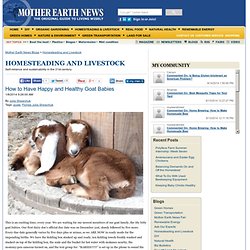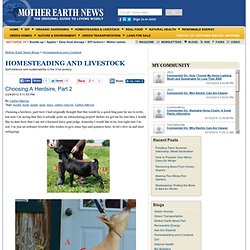

How To Tell If A Goat Is Pregnant. Kid (Baby Goat) Care & Information. How to Have Happy & Healthy Goat Babies. This is an exciting time, every year.

We are waiting for our newest members of our goat family, the itty bitty goat babies. Our first dairy doe’s official due date was on December 31st, closely followed by five more. Every due date generally varies by five days plus or minus, so we ARE NOW in ready mode for the impending births. We have the kidding box stocked up and ready, ten kidding towels freshly washed and stacked on top of the kidding box, the scale and the bucket for hot water with molasses nearby, the mommy-pen cameras turned on, and the text group for: “BABIES!!!!!!” Is set up in the phone to sound the “alarm” to the interns when the time comes. The Signs The Birth The average birth goes like this: it is cold and rainy out and night. The Preparation The secret to happy and healthy birthing is no secret at all, just good organization, a well-stocked kidding box and of course, a bit of luck. Sharing. Selecting A Herdsire, Part 1. February is such a fun month when it comes to goats… Half of us are watching goat kids being born, and the other half of us are still trying to get our does bred for the year!

I’m afraid I’m on the latter half this year, as my does are still lounging around in the barn, neither pregnant nor milking. Whoops. Thankfully I was able to locate a nice Nubian buck, and he will be coming next week to do some work. Better late than never right? I’ll have July goat kids this year, but at least I’ll have kids!! While perusing Craigslist this past week (oh what would we Americans do without Craigslist?!)
So let’s get down to the nitty gritty, and not beat around the bush. And that’s where the buck comes in. So, what is a dairy buck supposed to look like? This is an example of the ideal dairy buck. Buck #1 is a Nigerian Dwarf from Lost Prairie Nigerians, in Colorado. If you look at A, in the picture, he looks like he has a good topline; very straight and level. Choosing A Herdsire, Part 2. Choosing a herdsire, part two!

I had originally thought that this would be a quick blog post for me to write, but now I’m seeing that this is actually quite an intimidating project! Before we get too far into this, I would like to state here that I am not a licensed dairy goat judge. Someday I would like to be, but right now I’m not; I’m just an ordinary breeder who wishes to give some tips and pointers here. So let’s dive in and start critiquing! Both of the above goats are Nigerian Dwarfs, and I must say they are both quite stunning. These two bucklings are actually a little hard to critique, since they’re both so nice! The red letter “B” is at the brisket on both bucklings. On to “C” now. “D” shows the “rear leg angulation” (can you say that five times really fast?). Overall, both are extremely nice kids, who will mature into bucks that will be an asset to any herd. Now, it’s your turn to be the judge. First buck is from a breeder is Australia (no website at this time). Choosing A Herdsire, Part 3.